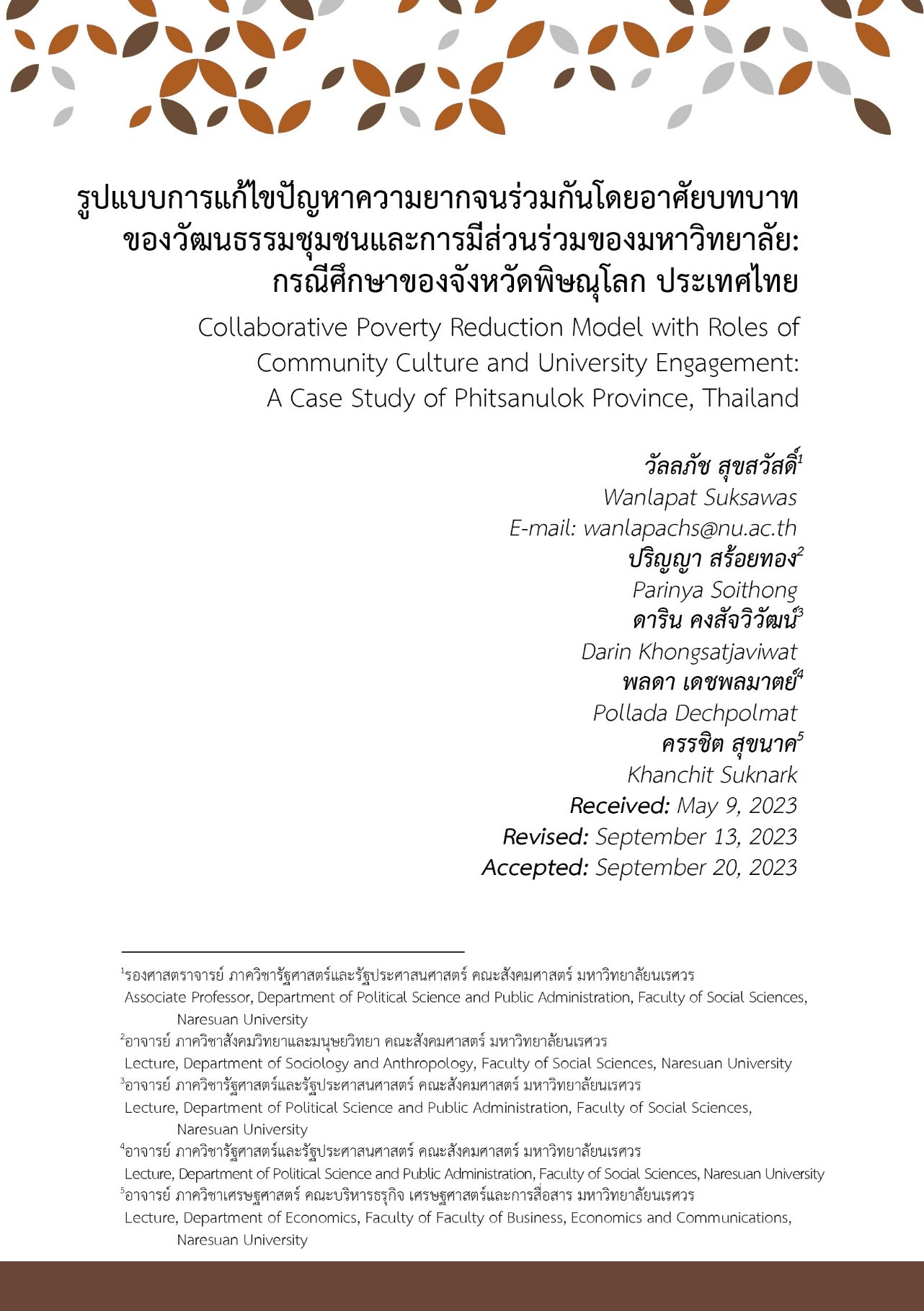Collaborative Poverty Reduction Model with Roles of Community Culture and University Engagement: A Case Study of Phitsanulok Province, Thailand รูปแบบการแก้ไขปัญหาความยากจนร่วมกันโดยอาศัยบทบาทของวัฒนธรรมชุมชน และการมีส่วนร่วมของมหาวิทยาลัย: กรณีศึกษาของจังหวัดพิษณุโลก ประเทศไทย
Main Article Content
Abstract
This research presents a compelling case study on how collaborative poverty reduction efforts in Phitsanulok Province, Thailand, benefit from the active involvement of universities and the rich cultural fabric of local communities. The main goal is to develop an innovative model for poverty reduction by harnessing the strengths of both university engagement and community culture. To accomplish this, the study adopted a participatory action research methodology, ensuring the meaningful participation of diverse stakeholders, such as researchers, local government officials, community leaders, civil servants, and civil society representatives. The findings revealed that community culture plays a pivotal role in the success of university engagement when addressing poverty-related challenges, particularly in the formation of effective working groups. These cultural elements shape the values, beliefs, and problem-solving practices that guide collaborative interactions. Additionally, the influence of traditional customs reinforces community culture, fostering cohesive working groups with shared goals and values. By adopting a collaborative approach, the study’s model exhibits significant potential for sustainability and scalability, allowing for tailored solutions that consider the unique needs and complexities of each community. The key lies in involving multiple sectors and stakeholders, with universities playing a crucial role, to promote well-coordinated, systematic, and enduring poverty reduction efforts.
Downloads
Article Details

This work is licensed under a Creative Commons Attribution-NonCommercial-NoDerivatives 4.0 International License.
References
Banerjee, A. V., & Duflo, E. (2014). Do firms want to borrow more? Testing credit constraints using a directed lending program. The Review of Economic Studies, 81(2), 572-607.
Berkes, F. (1999). Sacred ecology: Traditional ecological knowledge and resource management. Philadelphia: Taylor & Francis.
Bourdieu, P. (1986). The forms of capital. In J. Richardson (Ed.), Handbook of theory and research for the sociology of education (pp. 241-258). New York, NY: Greenwood Press.
Bozeman, B., & Youtie, J. (2016). Universities as partners in US federally funded research and development: A historical perspective. Technology Analysis & Strategic Management, 28(7), 739-755.
Cottom, T., O'Meara, K., & Owens, R. (2020). The role of higher education in community development: A review of the literature. Community Development, 51(4), 513-530.
Durkheim, E. (1997). The division of labor in society. New Work, NY: Free Press.
Duflo, E. (2017). The economist as plumber. American Economic Review, 107(5), 1-26.
Geertz, C. (2000). Available Light: Anthropological Reflections on Philosophical Topics. Princeton, NJ: Princeton University Press.
Hatch, M. J. (1993). The dynamics of organizational culture. Academy of Management Review, 18(4), 657-693.
Kabeer, N. (2005). Inclusive citizenship: Meanings and expressions. Commonwealth & Comparative Politics, 43(2), 230-253.
Kim, S., & Bagheri, A. (2019). Role of universities in poverty reduction: A conceptual framework. Journal of Poverty Alleviation and International Development, 10(2), 71-94.
National Economic and Social Development Board. (2020). Thailand's Poverty and Inequality Situation in 2019. Retrieved August 20, 2022, from http://www.nesdb.go.th/nesdb_en/ewt_w3c/ewt_dl_link.php?nid=10399
Narayan, D. (1999). Bonds and bridges: Social capital and poverty. Washington, DC: World Bank.
Sen, A. (2004). Why health equity? Health Economics, 13(7), 659-667.
United Nations. (2021). Goal 1: No Poverty. Retrieved August 20, 2022, from https://www.un.org/sustainabledevelopment/poverty/
United Nations Development Program. (2013). Higher education and the Sustainable Development Goals: Capacity and engagement for transformation. Retrieved August 20, 2022, from http://hdr.undp.org /sites/default/files/hd_publication_ajax/2013_human_development_report_en.pdf
World Bank. (2019). Poverty headcount ratio at $1.90 a day (2011 PPP) (% of population) - Thailand. Retrieved August 20, 2022, from https://data. worldbank.org /indicator/SI.POV.DDAY?locations=TH
World Bank. (2021). Poverty overview. Retrieved August 20, 2022, from https://www.worldbank.org/en/topic/poverty/overview


